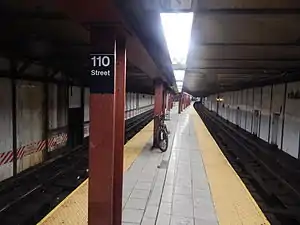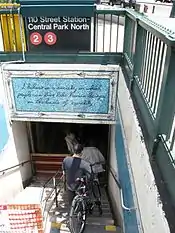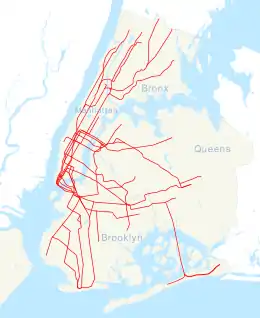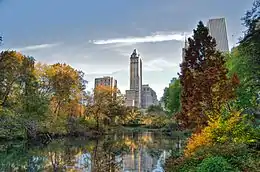Central Park North–110th Street station
Central Park North–110th Street (signed as 110 St–Central Park North on overhead signs) is a station on the IRT Lenox Avenue Line of the New York City Subway, located at the intersection of 110th Street and Lenox Avenue at the southern edge of Harlem, Manhattan. It is served by the 2 and 3 trains at all times.
Central Park North–110 Street | |||||||||||||||||||||||||||||||||||||||||||||||||||||||||||||||||||||||||||||||||||||||||
|---|---|---|---|---|---|---|---|---|---|---|---|---|---|---|---|---|---|---|---|---|---|---|---|---|---|---|---|---|---|---|---|---|---|---|---|---|---|---|---|---|---|---|---|---|---|---|---|---|---|---|---|---|---|---|---|---|---|---|---|---|---|---|---|---|---|---|---|---|---|---|---|---|---|---|---|---|---|---|---|---|---|---|---|---|---|---|---|---|---|
 North end of the platform, seen in 2015 | |||||||||||||||||||||||||||||||||||||||||||||||||||||||||||||||||||||||||||||||||||||||||
| Station statistics | |||||||||||||||||||||||||||||||||||||||||||||||||||||||||||||||||||||||||||||||||||||||||
| Address | West 110th Street & Malcolm X Boulevard New York, NY 10026 | ||||||||||||||||||||||||||||||||||||||||||||||||||||||||||||||||||||||||||||||||||||||||
| Borough | Manhattan | ||||||||||||||||||||||||||||||||||||||||||||||||||||||||||||||||||||||||||||||||||||||||
| Locale | Harlem | ||||||||||||||||||||||||||||||||||||||||||||||||||||||||||||||||||||||||||||||||||||||||
| Coordinates | 40.798749°N 73.952275°W | ||||||||||||||||||||||||||||||||||||||||||||||||||||||||||||||||||||||||||||||||||||||||
| Division | A (IRT) | ||||||||||||||||||||||||||||||||||||||||||||||||||||||||||||||||||||||||||||||||||||||||
| Line | IRT Lenox Avenue Line | ||||||||||||||||||||||||||||||||||||||||||||||||||||||||||||||||||||||||||||||||||||||||
| Services | 2 3 | ||||||||||||||||||||||||||||||||||||||||||||||||||||||||||||||||||||||||||||||||||||||||
| Transit | |||||||||||||||||||||||||||||||||||||||||||||||||||||||||||||||||||||||||||||||||||||||||
| Structure | Underground | ||||||||||||||||||||||||||||||||||||||||||||||||||||||||||||||||||||||||||||||||||||||||
| Platforms | 1 island platform | ||||||||||||||||||||||||||||||||||||||||||||||||||||||||||||||||||||||||||||||||||||||||
| Tracks | 2 | ||||||||||||||||||||||||||||||||||||||||||||||||||||||||||||||||||||||||||||||||||||||||
| Other information | |||||||||||||||||||||||||||||||||||||||||||||||||||||||||||||||||||||||||||||||||||||||||
| Opened | November 23, 1904 | ||||||||||||||||||||||||||||||||||||||||||||||||||||||||||||||||||||||||||||||||||||||||
| Station code | 441[1] | ||||||||||||||||||||||||||||||||||||||||||||||||||||||||||||||||||||||||||||||||||||||||
| Opposite- direction transfer | Yes | ||||||||||||||||||||||||||||||||||||||||||||||||||||||||||||||||||||||||||||||||||||||||
| Former/other names | 110 St–Central Park North | ||||||||||||||||||||||||||||||||||||||||||||||||||||||||||||||||||||||||||||||||||||||||
| Traffic | |||||||||||||||||||||||||||||||||||||||||||||||||||||||||||||||||||||||||||||||||||||||||
| 2019 | 2,666,985[2] | ||||||||||||||||||||||||||||||||||||||||||||||||||||||||||||||||||||||||||||||||||||||||
| Rank | 181 out of 424[2] | ||||||||||||||||||||||||||||||||||||||||||||||||||||||||||||||||||||||||||||||||||||||||
| Station succession | |||||||||||||||||||||||||||||||||||||||||||||||||||||||||||||||||||||||||||||||||||||||||
| Next north | 116th Street: 2 | ||||||||||||||||||||||||||||||||||||||||||||||||||||||||||||||||||||||||||||||||||||||||
| Next south | 96th Street: 2 | ||||||||||||||||||||||||||||||||||||||||||||||||||||||||||||||||||||||||||||||||||||||||
| |||||||||||||||||||||||||||||||||||||||||||||||||||||||||||||||||||||||||||||||||||||||||
| |||||||||||||||||||||||||||||||||||||||||||||||||||||||||||||||||||||||||||||||||||||||||
| |||||||||||||||||||||||||||||||||||||||||||||||||||||||||||||||||||||||||||||||||||||||||
| |||||||||||||||||||||||||||||||||||||||||||||||||||||||||||||||||||||||||||||||||||||||||
Built for the Interborough Rapid Transit Company (IRT), the 110th Street–Central Park North station was constructed as part of the city's first subway line, which was approved in 1900. Construction on the tunnel to the south of 110th Street started on August 30, and construction on the tunnel to the north started on October 2 of the same year. The station opened on November 23, 1904. The station's platform was lengthened in 1910.
The 110th Street–Central Park North station contains one island platform and two tracks. The station was built with tile and mosaic decorations. The platform contains exits to Lenox Avenue's intersections with 110th Street and 111th Street.
History
Construction and opening
Planning for the city's first subway line dates to the Rapid Transit Act, authorized by the New York State Legislature in 1894.[3]:139–140 The subway plans were drawn up by a team of engineers led by William Barclay Parsons, chief engineer of the Rapid Transit Commission. It called for a subway line from New York City Hall in lower Manhattan to the Upper West Side, where two branches would lead north into the Bronx.[4]:3 A plan was formally adopted in 1897, and legal challenges were resolved near the end of 1899.[3]:148 The Rapid Transit Construction Company, organized by John B. McDonald and funded by August Belmont Jr., signed Contract 1 with the Rapid Transit Commission in February 1900,[5] in which it would construct the subway and maintain a 50-year operating lease from the opening of the line.[3]:182 In 1901, the firm of Heins & LaFarge was hired to design the underground stations.[4]:4 Belmont incorporated the Interborough Rapid Transit Company (IRT) in April 1902 to operate the subway.[3]:182
The 110th Street–Central Park North station was constructed as part of the IRT's East Side Branch (now the Lenox Avenue Line). Farrell & Hopper began building the section from 110th Street to 135th Street on August 30, 1900. Farrell & Hopper started constructing the section from 103rd Street to 110th Street and Lenox Avenue on October 2, 1900.[5][6]:252 The excavation was relatively easy because the subway was under one side of Lenox Avenue and there were no street railway tracks to work around.[6]:252–253 At Lenox Avenue and 110th Street, a 6.5-foot (200 cm) diameter circular brick sewer, draining 124 acres (50 ha) of the west side of Manhattan, was intersected by the subway. A new sewer of equal diameter, but to a depth sufficient to pass beneath the subway was constructed on either side of the subway structure. Where the sewer passed beneath the subway, the brick sewer was replaced by three 42-inch (110 cm) diameter cast iron pipes.[6]:240
On November 23, 1904, the East Side Branch opened to 145th Street.[7][8] Initially, the station was served by East Side local and express trains. Local trains ran from City Hall to Lenox Avenue (145th Street). Express trains had their southern terminus at South Ferry or Atlantic Avenue and had their northern terminus at 145th Street or West Farms (180th Street).[9] Express trains to 145th Street were eliminated in 1906, and West Farms express trains operated through to Atlantic Avenue in Brooklyn.[10]
Service changes and station renovations
In 1909, to address overcrowding, the New York Public Service Commission proposed lengthening platforms at stations along the original IRT subway.[11]:168 On January 18, 1910, a modification was made to Contracts 1 and 2 to lengthen station platforms to accommodate ten-car express and six-car local trains. In addition to $1.5 million (equivalent to $41.2 million in 2019) spent on platform lengthening, $500,000 (equivalent to $13,719,643 in 2019) was spent on building additional entrances and exits. It was anticipated that these improvements would increase capacity by 25 percent.[12]:15 The platform at the 110th Street–Central Park North station was extended 145 feet (44 m) to the north.[12]:111 On January 23, 1911, ten-car express trains began running on the East Side Line.[11]:168[13]
In 1918, the Broadway–Seventh Avenue Line opened south of Times Square–42nd Street, thereby dividing the original line into an "H" system. Local trains were sent to South Ferry, while express trains used the new Clark Street Tunnel to Brooklyn.[14] The services at the station became 2 (West Farms express) and 3 (Lenox Avenue local) in 1948.[15] In 1959, all 2 and 3 trains became express.[16]
Starting on March 2, 1998, the tunnel was reconstructed along with the cracked tunnel floor. This was done to correct a major water problem that had existed for many years due to the presence of the Harlem Creek and other underground streams, which caused extensive flooding, water damage, and seepage problems that occasionally contributed to severe service disruptions.[17][18] The project cost $82 million and was finished on October 12, 1998.[17][19] During the reconstruction, many 2 trains were rerouted via the IRT Lexington Avenue Line, while the 3 trains were rerouted to the 137th Street–City College station on the IRT Broadway–Seventh Avenue Line. Each of the two Lenox Avenue Line tracks were alternately taken out of service and supplemental shuttle bus service connecting to other lines in the area were provided for much of this time.[20][21]
On March 27, 2020, a northbound 2 train caught fire as it entered the Central Park North–110th Street station, killing the operator, injuring at least 16 others, and damaging the station.[22][23] The incident was investigated as a possible arson, as several other fires had been observed in nearby stations.[24][25]
Station layout

| G | Street level | Exit/entrance | ||
| P Platform level |
Northbound | ← ← | ||
| Island platform | ||||
| ||||
| Island platform | ||||
| Southbound | | |||
The 110th Street–Central Park North station has two tracks and an island platform.[26] The 2 and 3 trains stop here at all times.[27][28] The platform was originally 350 feet (110 m) long, as at other stations north of 96th Street.[4]:4[29]:8 The platform is wider at its south end than at its north, where it was extended in the 1950s and the tracks curve.
This underground station is the southernmost station on the Lenox Avenue Line. South of this station, the line turns southwest under the Great Hill and North Woods of Central Park, then west under 104th Street, and then south once again at Broadway, merging with the IRT Broadway–Seventh Avenue Line to become the express tracks of that line.
Design
As with other stations built as part of the original IRT, the tunnel is covered by a "U"-shaped trough that contains utility pipes and wires. The bottom of this trough contains a foundation of concrete no less than 4 inches (100 mm) thick.[29]:9 The platform consists of 3-inch-thick (7.6 cm) concrete slabs, beneath which are drainage basins. The original platform contains circular, cast-iron Doric-style columns spaced every 15 feet (4.6 m), while the platform extensions contain I-beam columns. Additional columns beside the tracks, spaced every 5 feet (1.5 m), support the jack-arched concrete station roofs.[4]:4[29]:9 There is a 1-inch (25 mm) gap between the trough wall and the track walls, which are made of 4-inch (100 mm)-thick brick covered over by a tiled finish.[29]:9
The original decorative scheme consisted of blue/green tile panels and green and buff tile bands. The decorative work was performed by tile contractor John H. Parry.[29]:41 The station's artwork, installed during a 1998 renovation, is called Message from Malcolm by Maren Hassinger. It consists of mosaic panels on the platform and main fare control area's street stairs that depict quotes and writings by Malcolm X written in script and surrounded by mosaic borders.
Exits
This station has two fare control areas, both of which are on platform level. The full-time one is at the south end and has a bank of four turnstiles, token booth, and double-wide staircase going up to the northwest corner of Central Park North and Malcolm X Boulevard.[30] A full height turnstile at the center of the platform leads to a staircase that goes up to the northwest corner of West 111th Street and Malcolm X Boulevard.[30]
References
- "Station Developers' Information". Metropolitan Transportation Authority. Retrieved June 13, 2017.
- "Facts and Figures: Annual Subway Ridership 2014–2019". Metropolitan Transportation Authority. 2020. Retrieved May 26, 2020.
- Walker, James Blaine (1918). Fifty Years of Rapid Transit — 1864 to 1917. New York, N.Y.: Law Printing. Retrieved November 6, 2016.
- "Interborough Rapid Transit System, Underground Interior" (PDF). New York City Landmarks Preservation Commission. October 23, 1979. Retrieved November 19, 2019.
- Report of the Board of Rapid Transit Railroad Commissioners for the City of New York For The Year Ending December 31, 1904 Accompanied By Reports of the Chief Engineer and of the Auditor. Board of Rapid Transit Railroad Commissioners. 1905. pp. 229–236.
- Scott, Charles (1978). "Design and Construction of the IRT: Civil Engineering" (PDF). Historic American Engineering Record. pp. 208–282 (PDF pp. 209–283). Retrieved December 20, 2020.
 This article incorporates text from this source, which is in the public domain.
This article incorporates text from this source, which is in the public domain. - Report of the Public Service Commission For The First District of the State of New York For The Year Ending December 31, 1909. Albany: Public Service Commission. 1910. p. 191.
- "East Side Subway Open — Train from 145th Street to Broadway in 9 Minutes and 40 Seconds" (PDF). The New York Times. November 23, 1904. p. 1. ISSN 0362-4331. Retrieved March 27, 2016.
- The Merchants' Association of New York Pocket Guide to New York. Merchants' Association of New York. March 1906. pp. 19–26.
- Brooklyn Daily Eagle Almanac. Brooklyn Daily Eagle. 1916. p. 119.
- Hood, Clifton (1978). "The Impact of the IRT in New York City" (PDF). Historic American Engineering Record. pp. 146–207 (PDF pp. 147–208). Retrieved December 20, 2020.
 This article incorporates text from this source, which is in the public domain.
This article incorporates text from this source, which is in the public domain. - Report of the Public Service Commission for the First District of the State of New York For The Year Ending December 31, 1910. Public Service Commission. 1911.
- "Ten-car Trains in Subway to-day; New Service Begins on Lenox Av. Line and Will Be Extended to Broadway To-morrow". The New York Times. January 23, 1911. ISSN 0362-4331. Retrieved April 5, 2018.
- "Open New Subway Lines to Traffic; Called a Triumph — Great H System Put in Operation Marks an Era in Railroad Construction — No Hitch in the Plans — But Public Gropes Blindly to Find the Way in Maze of New Stations — Thousands Go Astray — Leaders in City's Life Hail Accomplishment of Great Task at Meeting at the Astor". The New York Times. August 2, 1918. p. 1. Retrieved November 6, 2016.
- "Open New Subway Lines to Traffic; Called a Triumph" (PDF). The New York Times. August 2, 1918. p. 1. ISSN 0362-4331. Retrieved October 4, 2011.
- "Wagner Praises Modernized IRT — Mayor and Transit Authority Are Hailed as West Side Changes Take Effect". The New York Times. February 7, 1959. p. 21. ISSN 0362-4331. Retrieved November 6, 2016.
- "New York City Transit - History and Chronology". mta.info. Metropolitan Transportation Authority. Archived from the original on March 24, 2020. Retrieved April 8, 2020.
- Lii, Jane H. (February 28, 1998). "Tunnel Work To Cut Service On 2 Subways". The New York Times. p. B-4. ISSN 0362-4331. Archived from the original on March 28, 2020. Retrieved January 17, 2020.
- Lueck, Thomas J. (October 13, 1998). "Beating Deadline, Normal Service Returns for the Nos. 2 and 3 Subway Lines". The New York Times. p. B-3. ISSN 0362-4331. Archived from the original on March 28, 2020. Retrieved January 17, 2020.
- Newman, Andy (December 12, 1997). "Repairs to Lenox Ave. Tunnel To Affect Many Subway Lines". The New York Times. p. B-8. Archived from the original on March 28, 2020. Retrieved July 31, 2013.
- "Lenox Rehab '98 2 3 Lenox Line Service Guide March 2-October 1998". thejoekorner.com. New York City Transit. 1998. Archived from the original on March 28, 2020. Retrieved November 6, 2016.
- "One dead, at least 16 hurt in New York City subway fire". NBC News. Retrieved 2020-03-27.
- "New York: man killed and at least a dozen hurt in subway fire, officials say". The Guardian. Associated Press. 2020-03-27. ISSN 0261-3077. Retrieved 2020-03-27.
- Tracy, Thomas. "Hero MTA train operator dies trying to evacuate commuters from Harlem subway fire, at least nine others hospitalized". nydailynews.com. Retrieved 2020-03-27.
- "'Hero' Train Conductor Dead, 16 Hurt in NYC Subway Fire; Blaze Probed as Suspicious: Officials". NBC New York. Retrieved 2020-03-27.
- Dougherty, Peter (2006) [2002]. Tracks of the New York City Subway 2006 (3rd ed.). Dougherty. OCLC 49777633 – via Google Books.
- "2 Subway Timetable, Effective September 13, 2020". Metropolitan Transportation Authority. Retrieved December 9, 2020.
- "3 Subway Timetable, Effective September 13, 2020". Metropolitan Transportation Authority. Retrieved December 9, 2020.
- Framberger, David J. (1978). "Architectural Designs for New York's First Subway" (PDF). Historic American Engineering Record. pp. 1-46 (PDF pp. 367-412). Retrieved 2020-12-20.
 This article incorporates text from this source, which is in the public domain.
This article incorporates text from this source, which is in the public domain. - "MTA Neighborhood Maps: Harlem / East Harlem" (PDF). mta.info. Metropolitan Transportation Authority. 2018. Retrieved October 1, 2018.
External links
| Wikimedia Commons has media related to Central Park North – 110th Street (IRT Lenox Avenue Line). |
- nycsubway.org – IRT White Plains Road Line: 110th Street/Central Park North
- nycsubway.org – Message from Malcolm Artwork by Maren Hassinger (1998)
- Station Reporter — 2 Train
- Station Reporter — 3 Train
- The Subway Nut – Central Park North–110th Street Pictures
- MTA's Arts For Transit – Central Park North–110th Street (IRT Lenox Avenue Line)
- 110th Street (Central Park North) entrance from Google Maps Street View
- 111th Street entrance from Google Maps Street View
- Platform from Google Maps Street View






.jpg.webp)
